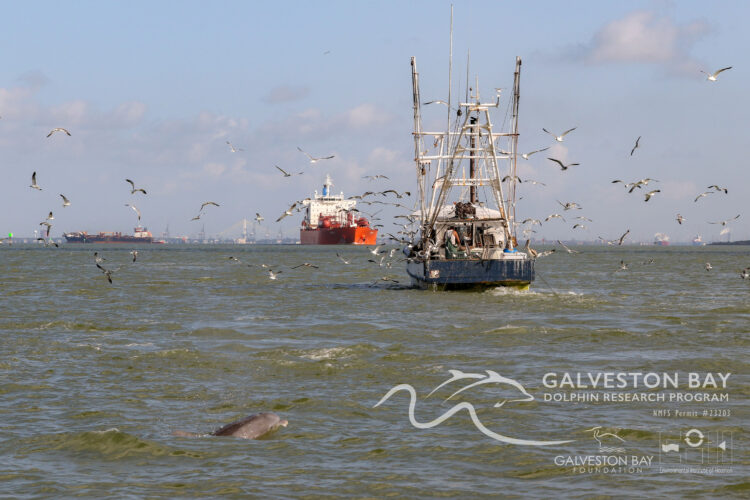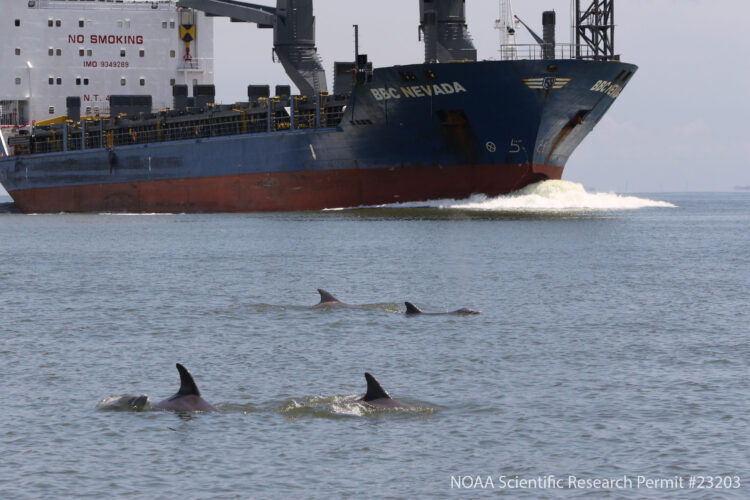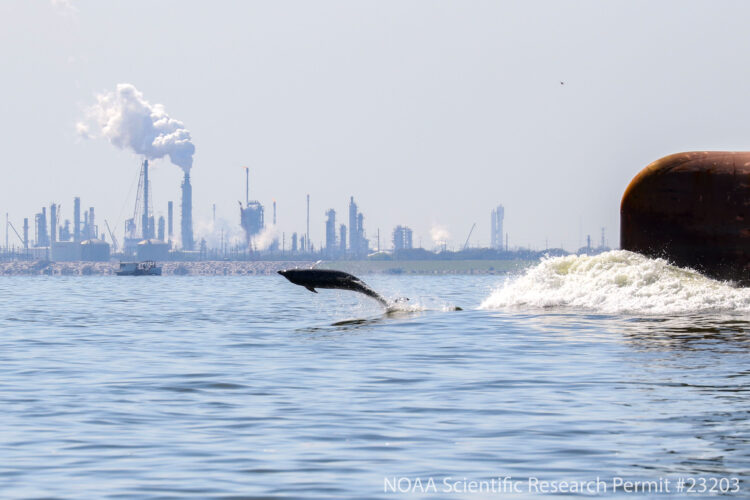By Katie Loesser
Set amongst the vast, shimmery waters of Galveston Bay, Texas, an arched, gray fin gracefully crests the surface. It is followed closely by the emergence of several others, just slightly out of sync. Their fluid motion unfaltering, the fins continue rotating forward. They descend below the surface in succession, just as quickly as they appeared.
The progression repeats itself again and again, as the pod continues on its way. As the lead dolphin reaches the surface once more, it exhales, spraying a short burst of water up into the air. This ephemeral plume is dwarfed by those in the distance, billowing out from the expanse of oil refineries lining the shore.
The Houston area is a highly industrialized landscape, featuring the largest petrochemical complex in the U.S. As such, the Houston area has been the scene of multiple oil and chemical spills as well as several hazardous waste sites, some of which persist today. There have also been multiple bottlenose dolphin Unusual Mortality Events — unexpected, fatal strandings that demand an immediate response —making it an important area to investigate dolphin health.
“Unfortunately, accidents happen, and with such a high concentration of industry, it’s inevitable that the local ecosystem has a long history of exposure to different types of chemical releases,” said Dr. Ryan Takeshita, lead scientist and deputy director of conservation medicine at the National Marine Mammal Foundation.
Takeshita is the lead investigator for a $2 million research project funded by the NOAA RESTORE Science Program in 2023. This project is a partnership between researchers and natural resource managers to investigate how the effects of two or more stressors on marine mammals may differ from either stressor by itself, especially when trying to calculate the injuries to marine mammals from specific sites or spills.
The team will use the Houston-area dolphins as a case study, specifically looking at the adverse health effects of exposure to dioxins and polychlorinated biphenyls (PCBs). They also aim to produce information on the cumulative effects of these stressors and to develop a conceptual model that will support natural resource managers in restoration decision making for dolphins.
Multiple Stressors, Multiple Vulnerabilities


A cellular and molecular biologist by training, Takeshita began working on marine mammals by chance. Prior to joining the foundation, he worked as a consultant on the Deepwater Horizon Natural Resource Damage Assessment (NRDA) case. The opportunity to study the sublethal effects of oil on Gulf of Mexico fish and marine mammals aligned well with his interest in understanding mechanisms of cellular function. That work launched his marine mammal career, connecting him with the foundation, the other project team members, and the dolphin populations of the Gulf.
“That population of dolphins in Galveston Bay is a pretty interesting group of animals because they can experience so many different types of stressors, in any given moment and over the course of their lifetimes,” Takeshita said.
As dolphins dive below the bay’s surface, they can find themselves in a noisy environment, surrounded by shipping and recreational vessels. Human-caused noise can cause stress by interfering with communication and echolocation. As they navigate through the Houston Ship Channel, a common foraging spot, they snatch up fish as they go. Yet, these fish can be contaminant-laden, accumulating pollution concentrated in the channel sediments as well as through the food web.
Because of their dietary exposure, dolphins continuously accrue ingested pollutants like dioxins and PCBs in their bodies throughout their more than 20-year lifespans. These contaminants are then passed from mother to calf during nursing, continuing their persistence in the population.
“We are preliminarily seeing that these dolphins have blubber concentrations of these pollutants that we know can be harmful on their own, but we really know nothing about what it means when they occur simultaneously.”
– Kristi Fazioli, research scientist with the Galveston Bay Dolphin Research Program
In addition to the many forms of human encounters dolphins face, including harassment, illegal feeding, and fisheries interactions, the Houston area also has frequent extreme weather events.
“Whether it’s dolphins displaced out of their normal habitat due to storm surge or freshwater flooding coming into the bay, these dolphins are periodically exposed to very low salinity water for extended periods of time,” said Dr. Teri Rowles, senior advisor for Marine Mammal Health Science at NOAA’s Office of Protected Resources. “Swimming in low salinity water can cause significant impacts on the dolphin’s health and may be lethal.”
Houston-area dolphins spend their entire lives in the estuary, making them more vulnerable to stressor exposure than a transient population. Resident populations are also smaller, so they can’t sustain as much loss through serious injury and mortality as their transient counterparts. Dolphins also reproduce slowly, which limits their ability to recover in the wake of a population decline.
“They don’t reproduce billions or thousands of eggs a year. They give birth to a single calf every three to six years,” Rowles said. “And so recovery for them takes a long time.”
This makes restoration efforts for long-lived species like dolphins more complex than other types of resources, such as restoring lost habitat. Instead of direct “like-for-like” habitat restoration projects that replace or offset affected acres, natural resource managers must find ways to mitigate existing impacts to help dolphin populations recover.
Collaborative Scoping
Managers can pursue restoration for injuries to natural resources, like dolphins, through NRDA cases. This legal process involves quantifying the extent of harm, identifying restoration options, and determining the monetary value needed to restore the injured resources. This process requires the collection of extensive information about natural resources and how they are impacted by stressors.
To determine the best way to support manager decision making, the team spent over a year planning the focus of their research project. That effort was funded by the NOAA RESTORE Science Program in 2021. The $65,113 award allowed researchers and resource managers to formally partner together in the collaborative scoping and design of their research project.
“One of the biggest problems that we have as researchers is trying to get money to cover our time to think through the right way to design a study and integrate partners from the get go,” Takeshita said. “Actually being able to pay people to talk about it and dedicate their time to strategic planning is what allowed us to put together a strong project with multiple partners to address this complicated issue.”

Dr. Michel Gielazyn is a natural resource manager on the team and an ecotoxicologist at NOAA’s Office of Response and Restoration, Assessment and Restoration Division. For over 20 years, she has worked on hazardous waste sites and NRDA cases, determining the impacts of contaminant releases on wildlife.
“The funding to bring the people together and sit in the room and work together, I’ve never really had that luxury,” Gielazyn said. “And I think that it improved this whole process and our entire project dramatically in a very beneficial way.”
The team hosted two scoping workshops, where they pulled in a comprehensive group of experts working at national, regional, and local levels. These collaborative discussions revealed key knowledge gaps for the project team to pursue and helped the group identify a manageable and specific subset of stressors in the Houston area to focus on.
“There’s so much going on, and you can’t have it all at once. And to me, when I look at all of the things that are happening, it can be almost overwhelming,” Gielazyn said. “By bringing in all the experts, we were able to drill down and prioritize the work to be done.”
Combined Effects of Dioxins and PCBs
Participants in the workshop agreed that dioxins and PCBs were important stressors for the project to investigate. These long-lasting contaminants have been released from multiple sites in the Houston area over many years. They can have chronic health impacts due to their effects on the immune system and reproduction, which have individual and population-level consequences.
“Knowing those contaminants are there, and knowing, based on our research, that the dolphins are exposed to them, made it our top priority,” said Kristi Fazioli, a research scientist with the Galveston Bay Dolphin Research Program, a partnership between the Galveston Bay Foundation and the Environmental Institute of Houston at the University of Houston Clear Lake.

She began assisting on projects studying the area’s dolphins as an undergraduate student, and has been with the program for the past decade, giving her a valuable on-the-ground perspective of what these dolphins are facing.
“We are preliminarily seeing that these dolphins have blubber concentrations of these pollutants that we know can be harmful on their own, but we really know nothing about what it means when they occur simultaneously,” Fazioli said.
Understanding the combined effects of multiple stressors is an important aspect of wildlife health that is gaining attention. “We’ve actually made good progress at modeling how one stressor might affect a population of animals,” Takeshita explained, “but then trying to layer in more than one stressor gets trickier.”
First, the project will work with the Texas Marine Mammal Stranding Network to quantify exposure by analyzing pollutant concentrations in blubber samples from stranded bottlenose dolphins. These results will be paired with other available health data from necropsy and pathology reports to get a more complete picture of the dolphins’ life history and associated stressors.The team will also perform bi-annual surveys to track population survival rates over time.
Because dioxins and PCBs affect similar molecular pathways, the team plans to conduct cell culture experiments in the lab. They will test the effect of each stressor in isolation as well as in combination to determine if there are any cumulative effects.
“The question is, when you expose the cells to both dioxins and PCBs, do you see just the same amount of effects added between the two, like the sum, or does it multiply?” Takeshita said. “Does it make it 10 times worse because of the combination, or do they cancel each other out and you don’t get any effects?”
By understanding the levels of contamination in Houston-area dolphins, tracking dolphin survival over time, and describing the cumulative effects of these contaminants, the team will produce detailed information that can be incorporated into quantitative models and NRDA decision-making frameworks. This will allow resource managers to better understand the situation in the Houston area.
With their field season on the horizon, the team is energized and looking forward to beginning the coordination of field work and preliminary laboratory analyses.
“We’re lucky because it’s a great group of people,” Takeshita said. “It’s people that are very well established in their fields and have a really good history of working together to answer these types of questions. So I’m excited to see the team in action.”
Cover image: Photo credit to the Galveston Bay Dolphin Research Program, NOAA Scientific Research Permit #23203
 Official websites use.gov
A .gov website belongs to an official government organization in the United States.
Official websites use.gov
A .gov website belongs to an official government organization in the United States.
 Secure .gov websites use HTTPS
A lock or https:// means you’ve safely connected to the .gov website. Share sensitive information only on official, secure websites.
Secure .gov websites use HTTPS
A lock or https:// means you’ve safely connected to the .gov website. Share sensitive information only on official, secure websites.